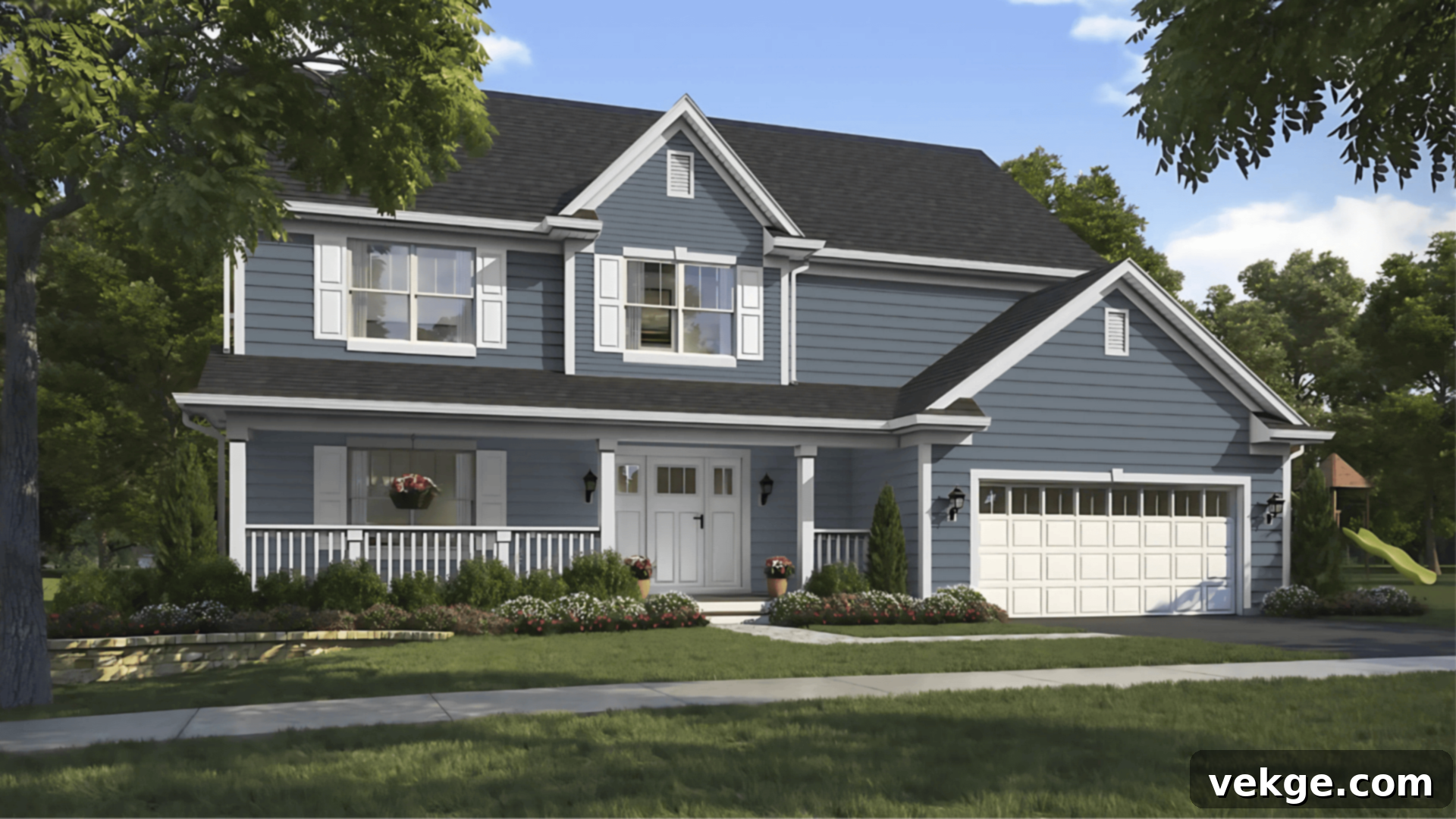Sherwin-Williams Storm Cloud (SW 6249): The Ultimate Guide to This Moody Blue-Gray Paint Color
Choosing the perfect gray paint for your home can feel like navigating a storm. What initially seems like a straightforward decision often becomes a quest, as you discover the vast spectrum of moody, dark-toned grays available. The challenge lies in finding a shade that delivers a bold statement without feeling cold, and one that is dramatic yet remains inviting and livable. I understand this dilemma intimately, having faced the same considerations when trying to pinpoint that ideal balance.
That’s precisely why I’ve meticulously crafted this comprehensive guide: to assist you in determining if Sherwin-Williams Storm Cloud (SW 6249) is the quintessential gray paint color to transform your living space. This detailed exploration aims to cut through the confusion and provide you with all the insights you need.
Throughout this guide, I will take you on a journey through the nuances of Storm Cloud. We’ll examine how this striking color manifests in various real-world homes, offering a glimpse into its versatile appeal. Furthermore, we’ll delve into a side-by-side comparison with other popular dark grays from Sherwin-Williams, helping you distinguish its unique characteristics. You’ll also uncover the most effective color pairings to complement Storm Cloud, ensuring a harmonious and cohesive design. Beyond aesthetics, I’ll equip you with practical tips on sampling techniques, smart purchasing strategies, and, crucially, how this captivating paint shifts and evolves under different lighting conditions. By the end, you’ll feel confident in your decision.
Getting to Know Sherwin-Williams Storm Cloud (SW 6249)

Storm Cloud (SW 6249) by Sherwin-Williams is far more than just a typical gray; it’s a profoundly deep, exceptionally moody gray infused with unmistakably strong blue undertones. This captivating hue is proudly featured within the Sherwin-Williams Blue Paint Colors collection, and it genuinely lives up to its name, evoking the serene yet powerful presence of an approaching storm. It delivers a dramatic, sophisticated, and deeply grounded feeling to any room it graces, creating an atmosphere that is both serene and impactful.
Basic Color Profile and What It Means for Your Home
Understanding a paint color’s basic profile is key to predicting how it will perform in your home. Here’s a closer look at Storm Cloud:
- HEX code: #7A848D
- LRV (Light Reflectance Value): 23
- Color family: Dark gray with strong blue influence
With an LRV of 23, Storm Cloud falls into the medium-dark range. The Light Reflectance Value (LRV) measures the percentage of light a color reflects. An LRV of 23 means Storm Cloud absorbs a significant amount of light rather than reflecting it. This low LRV is precisely what contributes to its moody, rich character, making it ideal for creating intimate and cozy spaces. It leans definitively into the saturated side of gray, offering a hue that is undeniably bold without ever feeling like an absolute black. Simultaneously, it possesses a distinct colorfulness derived from its blue undertones, yet it remains far from overtly bright. This exquisite balance is the secret to its remarkable versatility, allowing it to seamlessly enhance both ultra-modern and timelessly classic home aesthetics.
Unpacking Storm Cloud’s Distinctive Undertones
Storm Cloud is defined by its noticeable blue undertones, which are not merely subtle hints but rather a prominent feature that comes to life and shows up with varying intensity depending on the surrounding lighting conditions. These undertones are crucial to understanding its dynamic nature:
- In cool, natural daylight: When bathed in the soft, indirect light from north-facing windows or during overcast days, the blue undertone in Storm Cloud asserts itself more prominently. This can give the color a crisp, almost steely appearance, enhancing its cool and modern feel.
- Under warm, artificial light or direct sunlight: Conversely, when exposed to warmer light sources, such as incandescent bulbs or the golden glow of late afternoon sun, Storm Cloud can undergo a subtle yet perceptible shift. It might then feel more like a rich charcoal, or even reveal a delicate, almost dusty purple-gray nuance.
Because of this fascinating and significant color shift, it is absolutely essential to test Storm Cloud extensively in your own unique lighting environment. This crucial step should be taken before you commit to painting an entire room, as a sample swatch on a store wall simply cannot replicate the complex interplay of light in your home. Observing how it transforms throughout the day will prevent any unexpected surprises and ensure you love the final result.
Sherwin-Williams Storm Cloud in Real-World Spaces
The beauty of Storm Cloud lies in its chameleon-like ability to adapt and present itself differently within each room. Its appearance is profoundly influenced by elements such as the quality and direction of natural light, the type of artificial lighting, surrounding decor, and even the flooring choices. Below, we’ll explore how this versatile gray typically behaves in various domestic spaces, helping you envision where it might best fit into your home’s design narrative.
How It Looks in Different Rooms
Kitchens: Adding Depth and Modern Sophistication
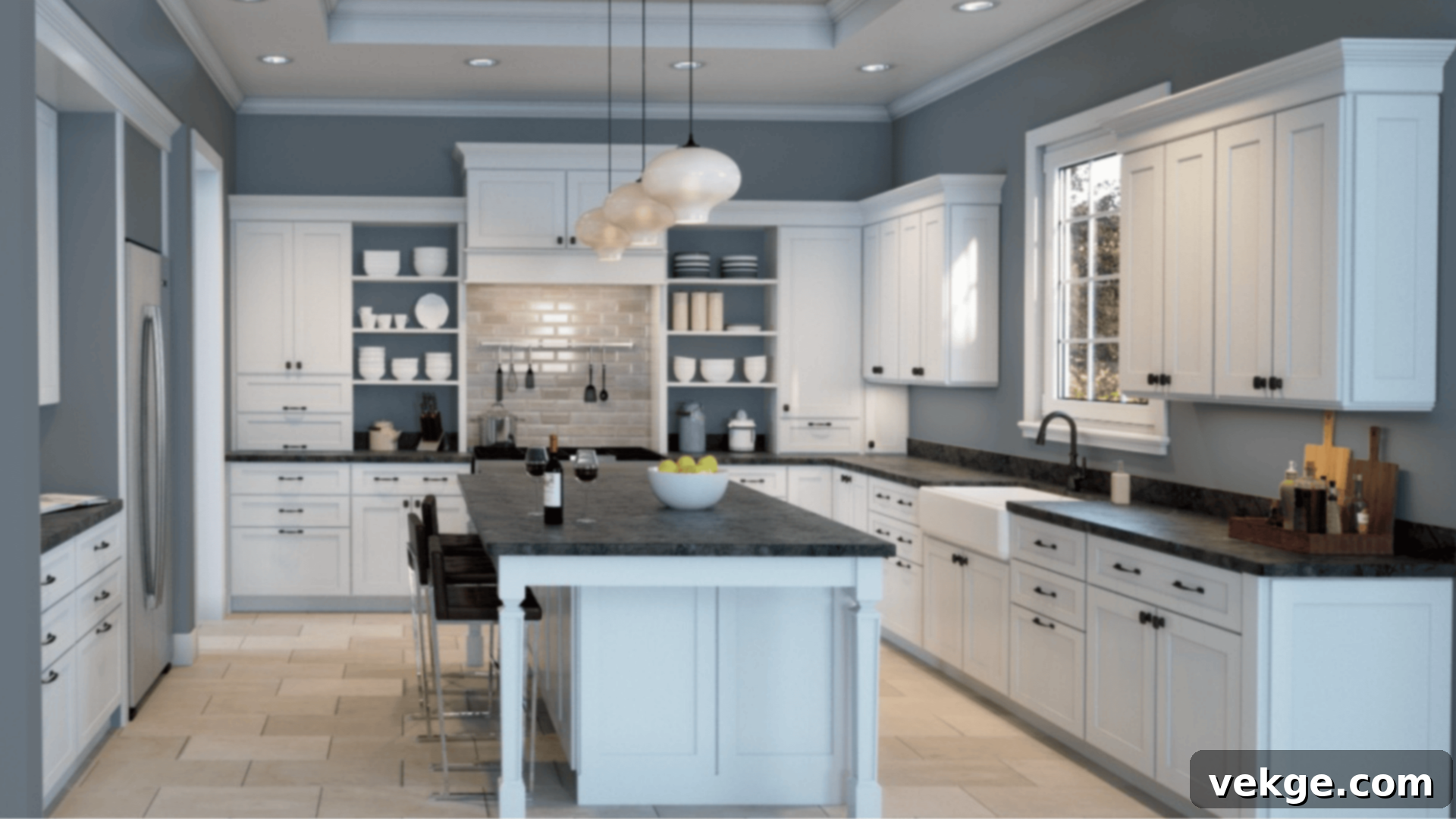
In kitchens, Storm Cloud instantly injects a profound sense of depth and undeniable drama. Its rich, deep hue with prominent blue undertones transforms an ordinary culinary space into a design statement. It’s an exemplary choice for lower cabinets, creating a grounded and sophisticated foundation, or for a striking accent wall that provides a bold backdrop. Imagine it paired with pristine white quartz or marble countertops, which offer a sharp, clean contrast that truly accentuates Storm Cloud’s cool elegance. Accessorizing with brass hardware can introduce a luxurious touch of warmth, while chrome or brushed nickel fixtures will enhance a sleek, more modern aesthetic. However, due to its low LRV of 23, Storm Cloud tends to absorb light. Therefore, it thrives best in kitchens that are generously illuminated by ample natural light or supplemented with robust artificial lighting to prevent the space from feeling overly dim or enclosed. For smaller kitchens, consider using it selectively, perhaps on an island or a single feature wall, to achieve drama without overwhelming the area.
Bathrooms: A Spa-Like Retreat with Boldness
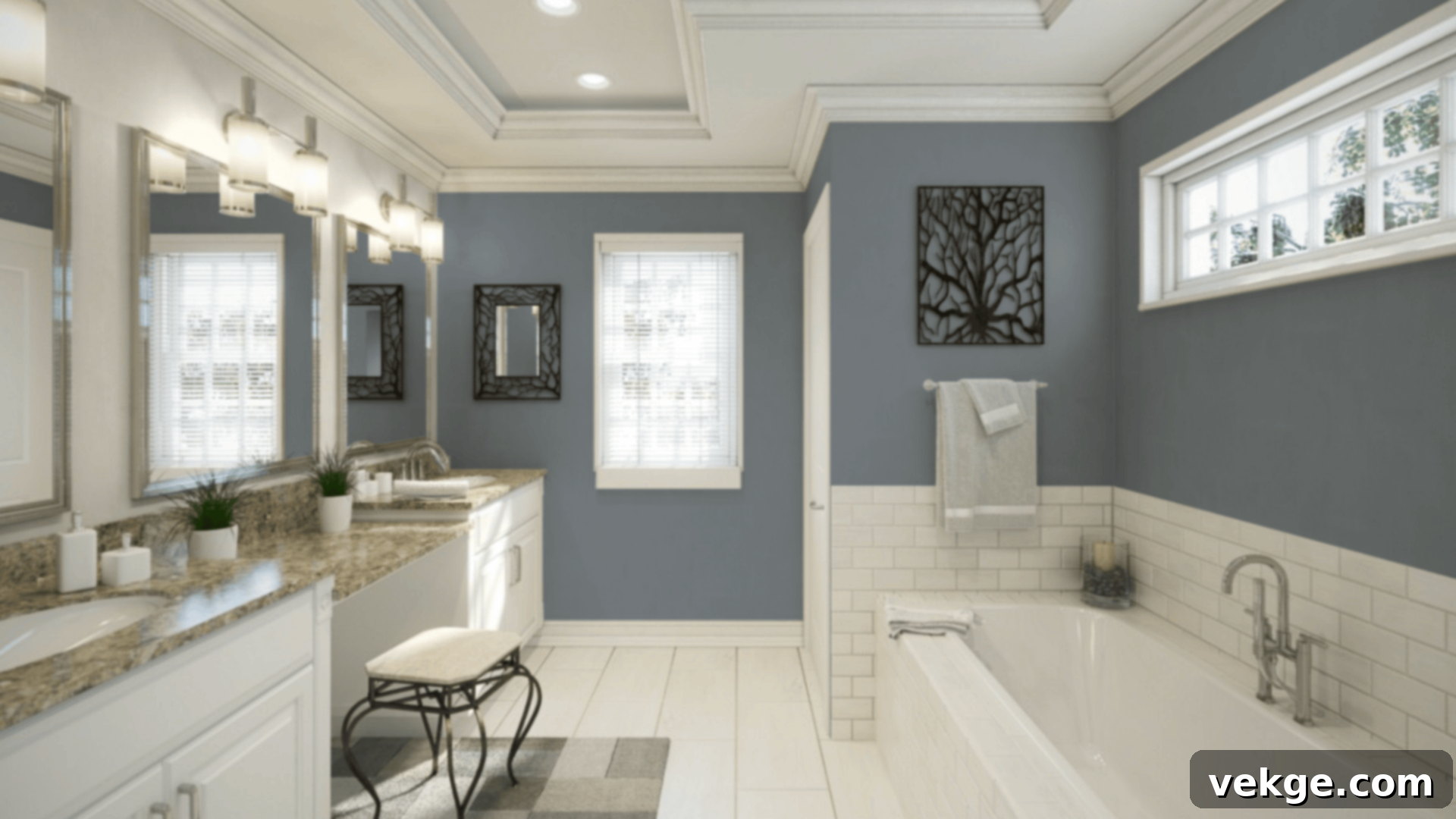
This exquisite gray paint possesses the power to make bathrooms feel both exceptionally bold and serenely spa-like. It creates an enveloping and sophisticated atmosphere perfect for unwinding. Storm Cloud looks absolutely stunning when combined with crisp white subway tiles, luxurious marble finishes, or modern black fixtures, which provide a striking contrast against its deep blue-gray base. The cool undertones contribute to a clean and refreshing feel, much like a high-end retreat. However, if your bathroom is on the smaller side or lacks natural light, Storm Cloud may appear too dark and can visually shrink the space. To counteract this, it’s crucial to balance its intensity with plenty of bright white trim, reflective surfaces like large mirrors, and strategic lighting to ensure the room remains bright and inviting.
Living Rooms: Setting a Calm, Modern Tone
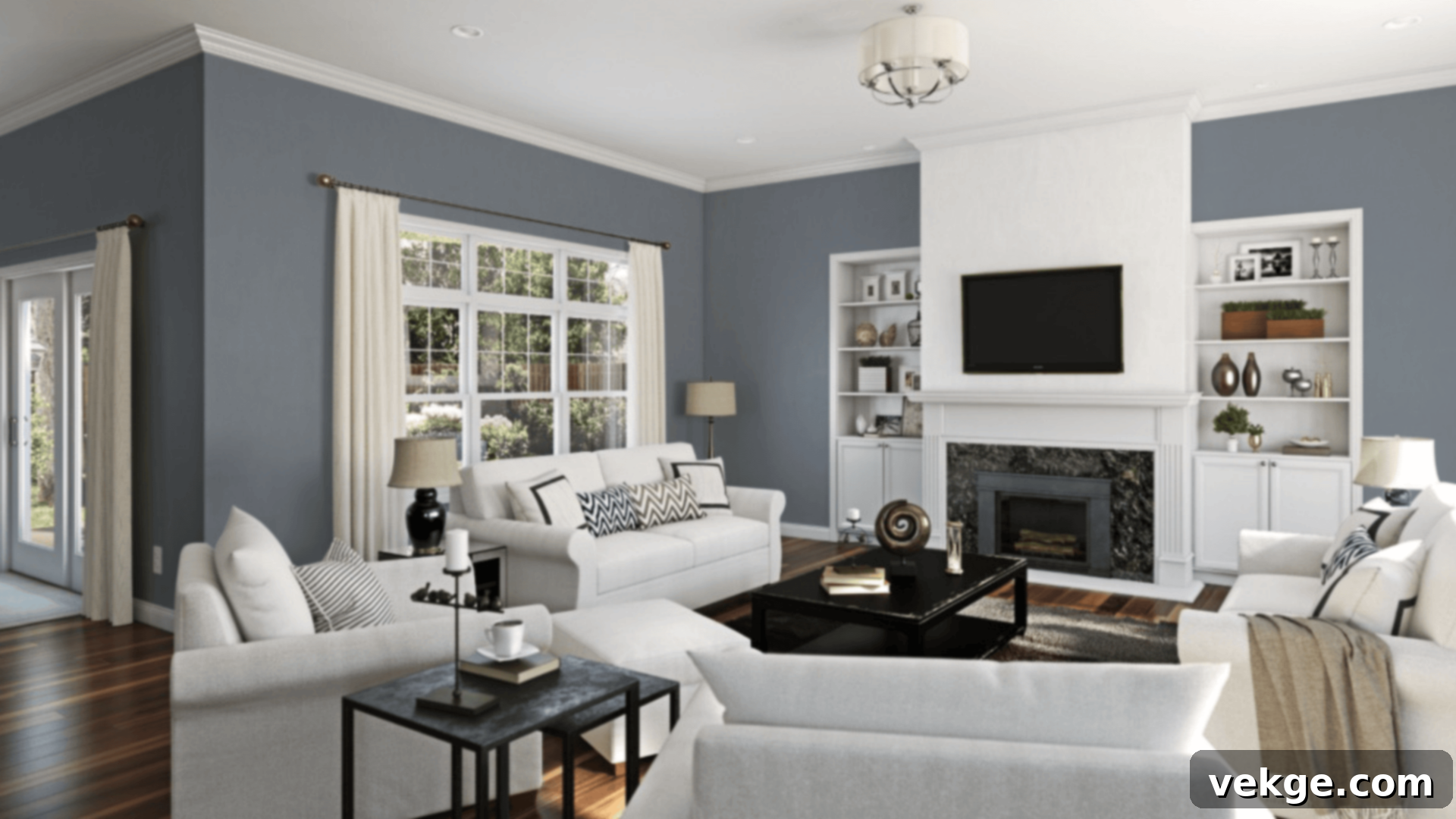
In living rooms, Sherwin-Williams Storm Cloud masterfully sets a calm, profoundly modern, and sophisticated tone. Its depth creates an immediate sense of intimacy and contemporary elegance, making it an excellent choice for a focal wall or an entire room. This color is particularly effective in spaces blessed with high ceilings or expansive windows, as the ample light can truly bring out its complex blue undertones without making the room feel enclosed. To maintain an airy feel and prevent the space from appearing too heavy, it’s advisable to introduce contrast with pristine white trim, lighter-toned furniture, or vibrant art. Complementary textiles like soft throws and plush pillows in creams, blues, or even subtle pinks can further soften its intensity and add layers of comfort.
Bedrooms: Embracing Cozy, Moody Serenity
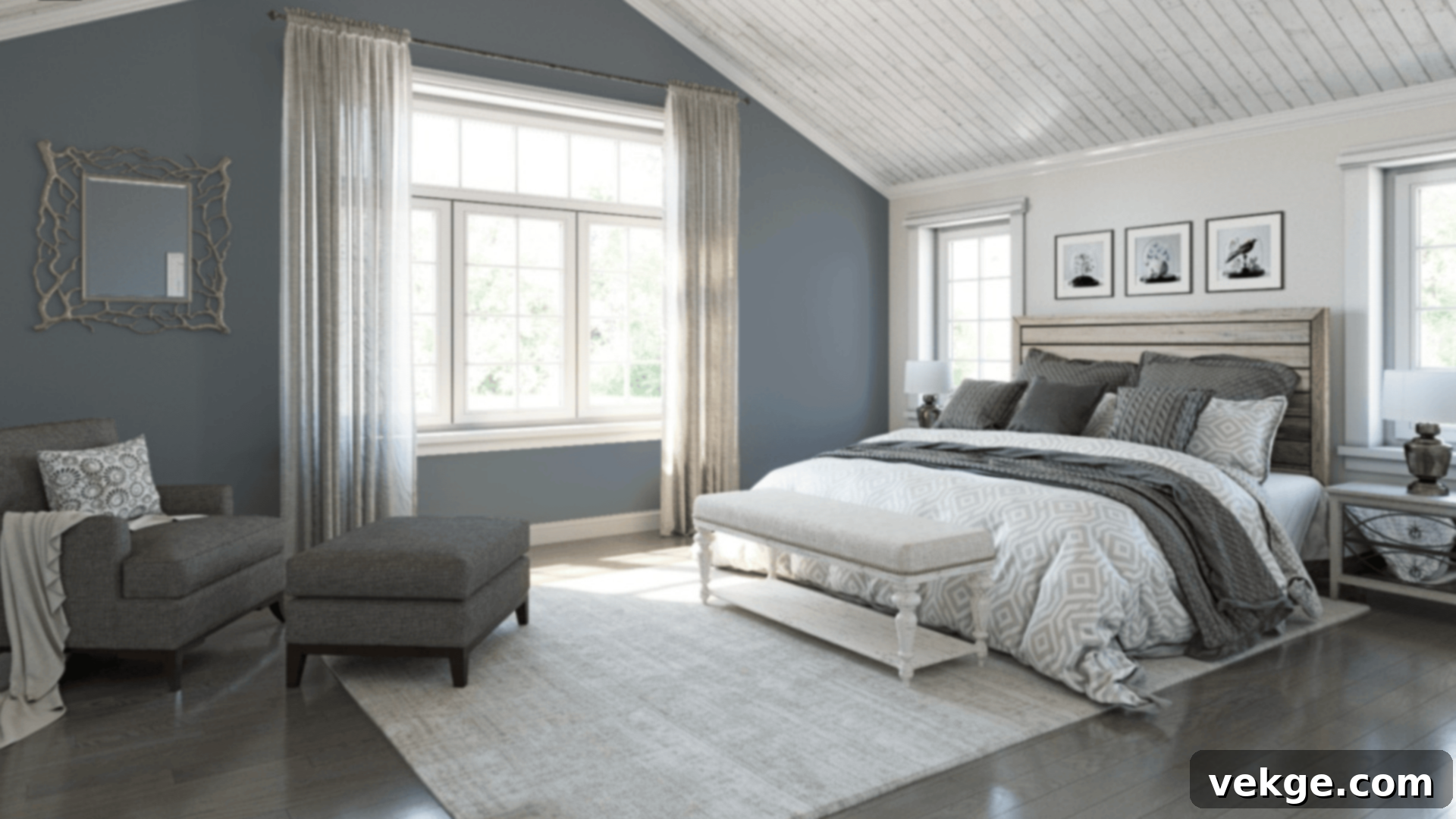
If your vision for a bedroom is a deeply cozy, intimately moody, and utterly serene retreat, Storm Cloud is an exceptional choice that delivers precisely that ambiance. Its enveloping depth fosters a sense of tranquility and comfort, perfect for winding down. It pairs exquisitely with luxurious layered bedding in crisp whites, muted grays, or soft blues, creating a harmonious and inviting haven. Soft, ambient lighting, perhaps from bedside lamps or dimmable fixtures, enhances its rich character. Accents in warm wood tones, polished gold, or brushed brass will introduce a touch of elegance and warmth, balancing the cool gray. Nevertheless, it’s important to be mindful of its application in particularly small rooms; if not carefully balanced with lighter elements and strategic lighting, it can visually reduce the perceived size of the space. Consider using it on an accent wall in smaller bedrooms to achieve the desired mood without overwhelming the room.
Ultimately, Storm Cloud is best suited for spaces where your primary goal is to create a distinct atmosphere, achieve striking contrast, or infuse a touch of sophisticated drama, without committing to the absolute darkness of a true black.
How Lighting Drastically Affects Storm Cloud
As a color with a lower LRV (23), Storm Cloud is inherently sensitive to light, and its appearance can dramatically shift based on your room’s orientation and the type of lighting it receives throughout the day. This dynamic quality is part of its charm but also requires careful consideration:
- North-facing rooms: These rooms receive cooler, indirect light, which will consistently enhance Storm Cloud’s blue undertones. Expect it to appear as a deeper, more pronounced blue-gray, with a slightly steely or crisp feel. It can lean towards a sophisticated navy-gray here.
- South-facing rooms: Abundant, warmer light softens Storm Cloud, making it appear more balanced and perhaps slightly less intense. The blue undertones might still be present but will be warmed, giving it a richer, more complex charcoal-like quality.
- East-facing rooms: Morning light, which is typically bright and somewhat cool, will accentuate Storm Cloud’s cooler edge. In this light, it can feel brisk, crisp, and very clean. As the day progresses, it will transition into a more balanced gray.
- West-facing rooms: The intense, golden glow of late afternoon and evening sun can dramatically alter Storm Cloud’s perception. This warm light often pulls out more muted purple or deep navy hues, making the color feel richer and more complex, sometimes even slightly enigmatic.
Given these significant shifts, it is absolutely paramount to test the color on multiple walls within your space and at different times of day. Observe how it changes from morning to evening, and how it looks under both natural light and your artificial lighting setup. Because of its lower LRV of 23, Storm Cloud absorbs a considerable amount of light, meaning its visual impact and perceived hue will vary dramatically from one room to another, and even from one wall to another within the same room.
Storm Cloud vs. Other Sherwin-Williams Grays: A Comparative Analysis
Sherwin-Williams offers an impressive array of moody gray options, making the selection process wonderfully rich yet potentially overwhelming. It’s easy to find yourself caught between several appealing contenders. Here’s how Storm Cloud distinctively measures up against some of Sherwin-Williams’ other top-performing dark grays, helping you discern its unique personality.
Storm Cloud vs. Web Gray (SW 7075)
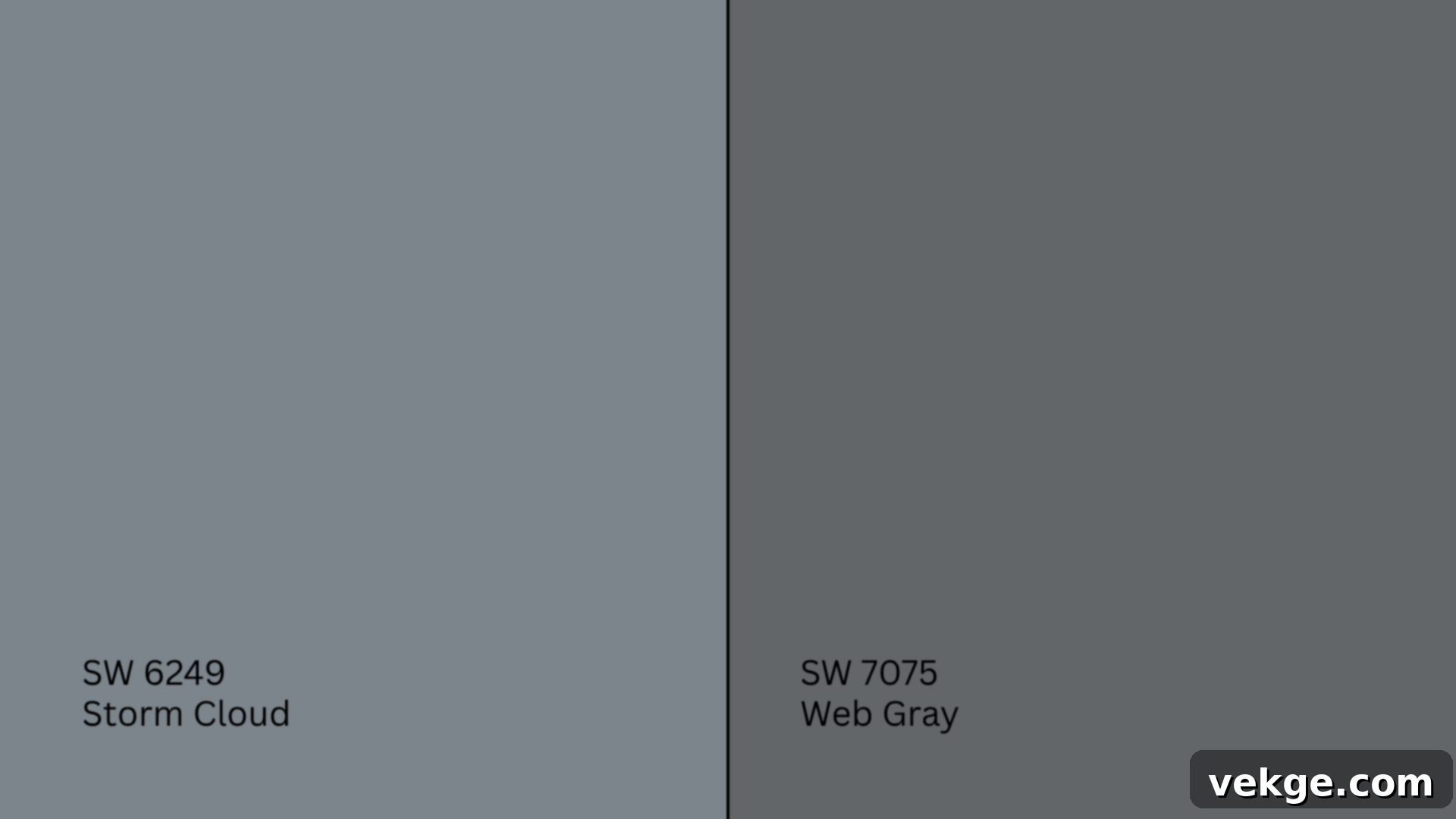
Web Gray (SW 7075, #616669) presents itself as a notably darker and more distinctly neutral gray, possessing considerably less blue than Storm Cloud. It often reads as a true charcoal.
- Web Gray offers a sophisticated, almost pure charcoal-like appearance, making it an excellent, softer alternative to stark black. It leans heavily into a neutral gray scale.
- Storm Cloud, in contrast, consistently projects a more discernible blue character, giving it a fresher, more contemporary, and cooler feel in most spaces. Its blue undertone adds a layer of complexity and personality.
If your preference is for an unadulterated, dark, and unequivocally neutral gray that serves as a modern black substitute, then Web Gray is likely your ideal choice. However, if you are drawn to cooler, deeper tones that carry a sophisticated hint of color and distinct personality, Storm Cloud will deliver that desired effect beautifully.
Storm Cloud vs. Grizzle Gray (SW 7068)
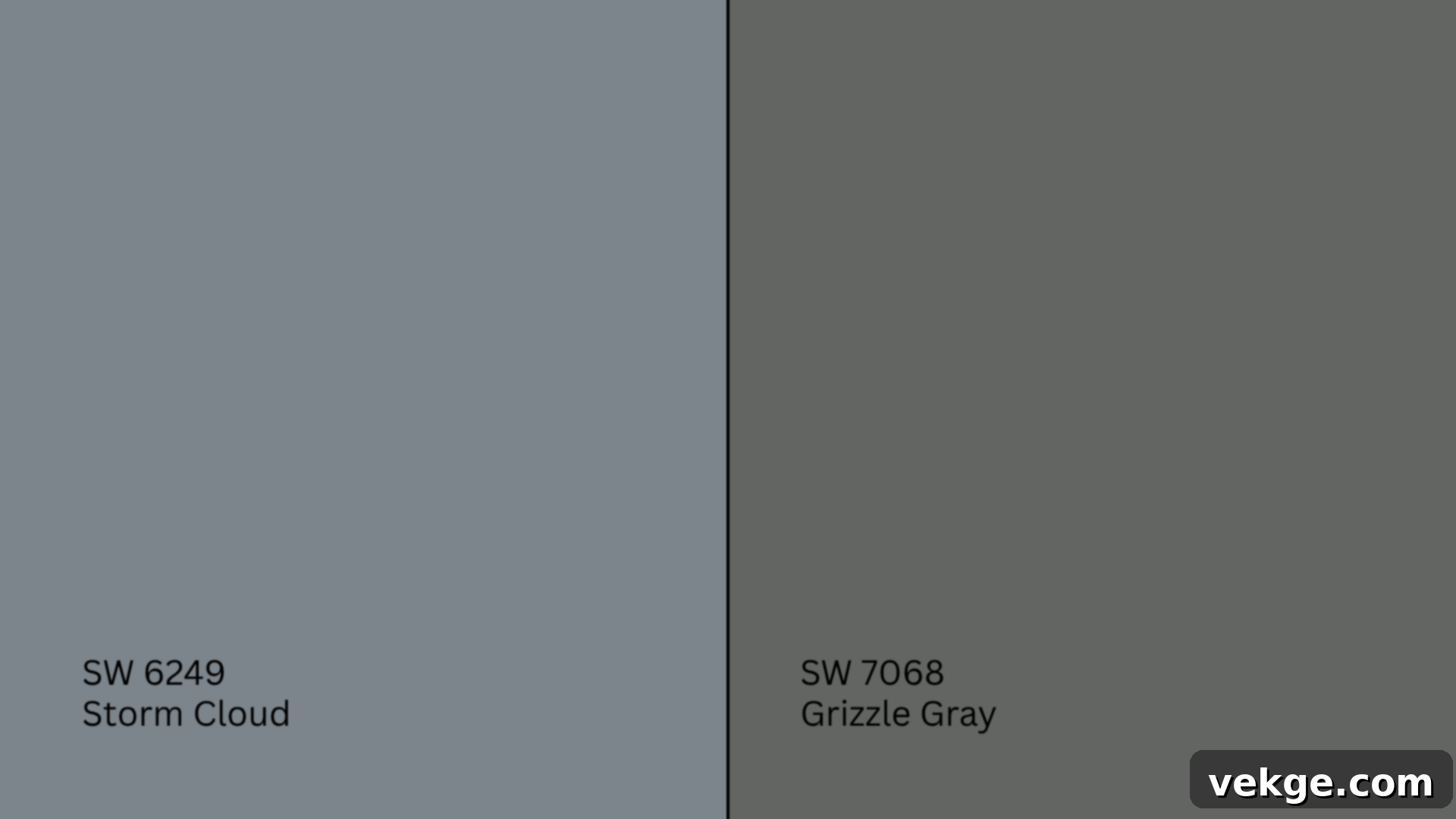
Grizzle Gray (SW 7068, #636562) is another profoundly rich and deeply saturated gray, yet its defining characteristic is a clear lean towards green undertones, offering a distinct departure from Storm Cloud’s blue.
- Grizzle Gray possesses a strong green undertone that gives it a more earthy, organic, and often warmer feel, making it perfect for spaces that aim for a natural or rustic aesthetic.
- Storm Cloud, conversely, is grounded in a clear blue base, which consistently makes it feel cleaner, crisper, and unequivocally cooler by comparison.
Opt for Grizzle Gray if you are designing rustic-inspired spaces or desire an earthy, muted depth. Select Storm Cloud when your goal is to achieve a striking, modern contrast with a cool and clear demeanor.
Storm Cloud vs. Peppercorn (SW 7674)
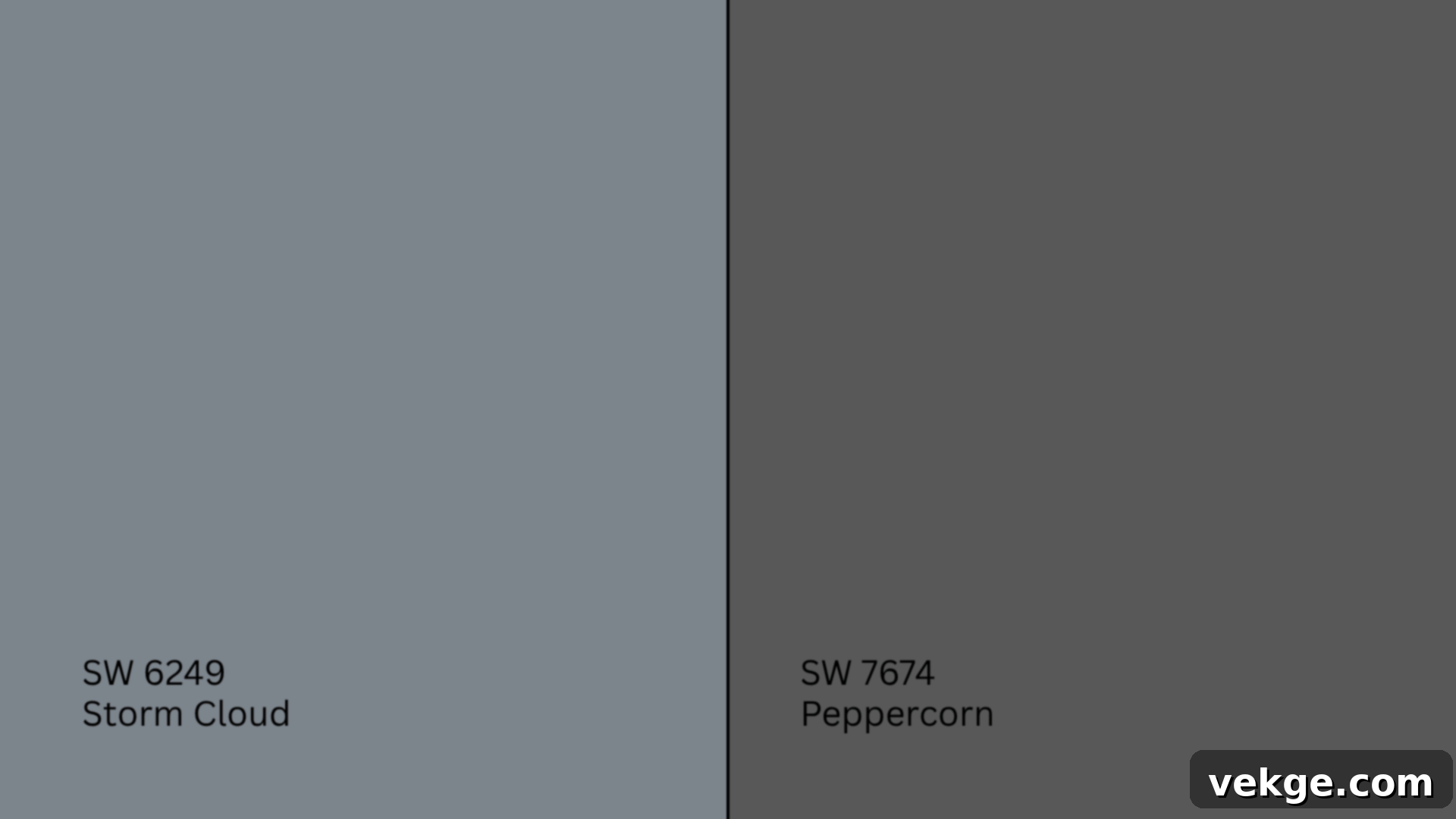
Peppercorn (SW 7674, #585858) stands out as one of Sherwin-Williams’ darkest and most popular gray paint colors, often being mistaken for an off-black due to its intense depth.
- Peppercorn is significantly closer to a true, deep black, characterized by exceptionally subtle, almost imperceptible warmth in its undertones, making it a very sophisticated near-black.
- Storm Cloud, in comparison, is noticeably lighter and far more colorful and vibrant. Its distinct blue undertones give it a unique personality that prevents it from ever feeling just like a muted black.
If your design ambition is to achieve maximum drama and intensity but you find pure black too severe, Peppercorn offers an elegant solution. However, if you desire a deep, moody aesthetic that is bold yet retains a distinct color and avoids the profound darkness of a near-black, Storm Cloud provides an excellent and vibrant middle ground.
Storm Cloud vs. Slate Tile (SW 7624)
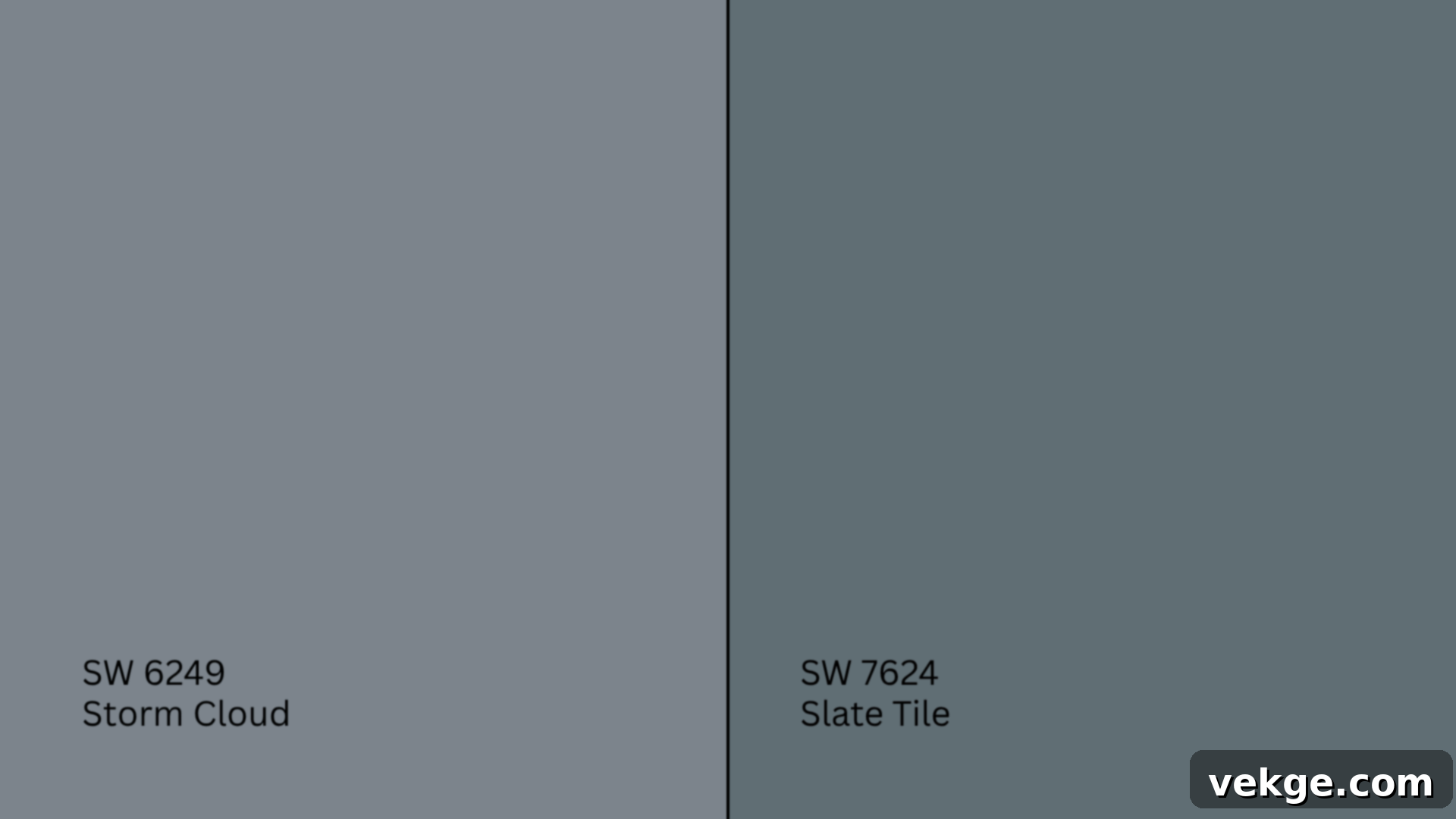
Slate Tile (SW 7624, #606E74) can be considered a very close cousin to Storm Cloud, sharing a similar deep blue-gray family but with subtle yet significant differences.
- Slate Tile is just marginally lighter than Storm Cloud and often presents as a more balanced, slightly more neutral blue-gray, making it a touch softer and potentially more versatile for some.
- Storm Cloud, by contrast, consistently leans darker and exhibits a more pronounced blue quality, giving it a bolder and more dramatic presence.
These two colors are frequently tested side-by-side by homeowners precisely because of their close resemblance. Slate Tile often feels a bit “safer” or more understated for those who prefer a less intense shade, while Storm Cloud distinctively feels a bit bolder and more commanding, offering a deeper saturation of that desired blue-gray mood.
Undertone and LRV Comparison Table
To help you visualize these differences more clearly, here’s a quick reference table:
| Paint Color | Primary Undertones | LRV | Overall Feel (Warm or Cool) |
|---|---|---|---|
| Storm Cloud (SW 6249) | Pronounced Blue | 23 | Distinctly Cool |
| Web Gray (SW 7075) | Neutral Charcoal | 13 | Cool (but more neutral) |
| Grizzle Gray (SW 7068) | Earthy Green-Gray | 13 | Cool (with earthy warmth) |
| Peppercorn (SW 7674) | Subtle Warm Charcoal | 10 | Neutral-Warm (near-black) |
| Slate Tile (SW 7624) | Balanced Blue-Gray | 15 | Cool |
While these comparisons offer valuable insights, remember that the true test happens on your walls. It is highly recommended to test all your top contenders in your actual space, as these popular colors are celebrated for good reasons, but their behavior and perceived hue will never be identical across different environments.
Best Color Pairings for Sherwin-Williams Storm Cloud
Sherwin-Williams Storm Cloud truly shines and reaches its full potential when strategically paired with the right trims, accent colors, and various finishes. Whether your design goal is to create high contrast or achieve seamless cohesion, understanding what works well with Storm Cloud is essential for a polished look. Here’s a curated list of suggestions to inspire your design choices:
Trim and Ceiling Color Suggestions
The right trim and ceiling color can elevate Storm Cloud, framing its moody depth beautifully:
- Pure White (SW 7005, #EDECE6): This is a classic and reliable choice. Pure White is crisp and clean, offering a strong, refreshing contrast that makes Storm Cloud pop without looking sterile or overly stark. It maintains a bright boundary.
- Alabaster (SW 7008, #EDEAE0): For those seeking a softer transition, Alabaster is a beautifully warm white. It introduces a gentle creaminess that subtly softens Storm Cloud’s inherent cooler tone, creating a more inviting and harmonious feel, especially in bedrooms or living areas.
- High Reflective White (SW 7757, #F7F7F1): This is Sherwin-Williams’ brightest and purest white. It’s the ultimate choice for achieving ultra-modern, high-contrast designs where you want the trim to stand out sharply against the deep gray walls, maximizing the reflective quality.
For ceilings, consider a flat or matte finish, which absorbs light and helps to visually recede, emphasizing the wall color and hiding minor imperfections. For trim, doors, and moldings, opt for a semi-gloss or satin finish; these finishes offer durability, easy cleaning, and a subtle sheen that helps to define architectural lines beautifully without creating excessive glare.
Accent Wall and Furniture Colors: Crafting Your Desired Aesthetic
Storm Cloud provides an incredible backdrop for a variety of accent and furniture choices, depending on the mood you wish to create:
- For a layered, moody, and sophisticated vibe: Pair Storm Cloud with other complementary deep tones and subtle textures. Think soft off-whites, sophisticated navy blues, dusty mauves for an unexpected hint of color, rich forest greens for an organic touch, or light to medium wood tones to introduce warmth and natural texture. Velvets and chenilles in these colors would look stunning.
- For a high-contrast modern and sleek look: Embrace bold and reflective elements. Incorporate metallic accents like polished brass, clean matte black, or deep, rich walnut wood for furniture. Vibrant emerald green or sapphire blue accents can add a pop of jewel-toned luxury. Warm leathers and creamy beige textiles or upholstery are excellent for balancing the cool undertones of Storm Cloud, adding comfort and grounding the space.
When selecting furniture, consider using neutral anchor pieces such as sofas in light gray, warm tan, creamy beige, or natural linen fabrics. Then, layer in personality and depth with textured pillows, soft throws, and strategic use of metal hardware or decorative objects.
Hardware and Flooring Compatibility: Grounding Your Design
Storm Cloud is remarkably versatile, playing beautifully with both warm and cool-toned materials, allowing for diverse design expressions:
- Brass hardware: This metallic choice adds undeniable warmth and a touch of vintage elegance, beautifully softening Storm Cloud’s prominent blue undertone. It creates a rich, inviting contrast.
- Polished chrome or brushed nickel: These cool-toned metals enhance the modern, sleek, and crisp edge of Storm Cloud, contributing to a contemporary and clean aesthetic. They provide a sharp, bright contrast.
- Matte black hardware: Offering a bold, sharp contrast, matte black fixtures and hardware feel incredibly sleek, grounded, and undeniably modern. It’s a powerful choice for a strong visual statement.
When it comes to flooring, Storm Cloud pairs exceptionally well with two distinct directions, each creating a different ambiance:
- Light wood or bleached oak flooring: Opting for lighter wood tones helps to visually open up the room, creating an airy and expansive feel. This pairing ensures the space remains bright and prevents the deep wall color from feeling too heavy or overwhelming.
- Medium-to-dark walnut or deep engineered wood: These richer wood tones add significant depth and a luxurious richness to the room, perfectly balancing the bold wall color. This combination creates a sophisticated, grounded, and often more traditional or transitional aesthetic.
A crucial tip: try to avoid overly orange-toned woods, as their strong warm hue can sometimes clash unpleasantly with Storm Cloud’s cool blue undertones, creating a less harmonious effect.
Paint Finish Recommendations for Sherwin-Williams Storm Cloud
The finish you choose for your paint can dramatically alter how Storm Cloud appears and feels in a room, influencing its durability, sheen, and the way it interacts with light. Here’s a breakdown of recommended finishes and their ideal applications:
- Matte: This finish possesses the least sheen, offering a velvety, sophisticated look. It beautifully softens Storm Cloud’s bold tone, making it ideal for bedrooms or other quiet, intimate spaces where a serene, non-reflective surface is desired. However, matte finishes are generally less durable and harder to clean, making them less suitable for high-traffic areas.
- Eggshell: Providing a subtle, low-sheen finish, eggshell adds a gentle depth to Storm Cloud while still being relatively forgiving. It’s an excellent choice for living rooms, dining rooms, and other areas with moderate wear and tear, offering better durability and cleanability than matte without excessive shine.
- Satin: Offering a noticeable sheen that is both durable and easy to clean, satin is a highly versatile finish. It has a slight luster that enhances Storm Cloud’s blue undertone, making it particularly suitable for kitchens, bathrooms, hallways, and children’s rooms where moisture and frequent cleaning are concerns.
- Semi-Gloss: This finish boasts a higher sheen and exceptional durability, making it the best choice for trim, doors, and cabinetry. It provides a sleek, crisp contrast against the walls and stands up well to frequent handling and cleaning. For full walls in most rooms, semi-gloss can be too shiny and highlight imperfections.
- Gloss: An ultra-reflective and bold finish, gloss paint creates a mirror-like shine. While typically too intense for entire walls, it can be used sparingly on furniture, accent pieces, or specific architectural details where you desire a major shine and a high visual impact, turning them into focal points.
If you’re still uncertain which finish is right for your project, a practical tip is to paint a small sample square of Storm Cloud in each desired finish. Observe how light reflects off each one at various times of day and how they complement your room’s overall aesthetic before making your final decision.
Sampling and Buying Options for Sherwin-Williams Storm Cloud
Making the right paint choice involves proper sampling and knowing where to purchase. Here’s how to navigate these crucial steps for Storm Cloud:
Where to Get Peel-and-Stick Samples (Highly Recommended!)
Physical paint swatches can be misleading. Peel-and-stick samples provide a much more accurate representation:
- Samplize: This is a fantastic resource, offering genuine paint samples made with two coats of actual paint on an adhesive backing. They are mess-free, easily removable, and incredibly accurate, allowing you to reposition them on different walls and observe the color under various lighting conditions without committing to a full paint job or messy samples.
- Sherwin-Williams stores: Your local Sherwin-Williams retail location will typically stock small, inexpensive sample jars of Storm Cloud, along with traditional paint cards. These are good for an initial look, but less effective for seeing how the color truly lives in your space.
- Local hardware stores: Many well-stocked hardware stores (like Lowe’s or independent retailers) may carry Sherwin-Williams products or offer color-matching services, allowing you to get a sample jar of a close match if Storm Cloud isn’t directly available.
For the most accurate assessment, place these samples on various walls in your room. Observe them in both the morning and evening light, as well as under your artificial lighting, before making your final, confident decision. This step is non-negotiable for a successful paint project.
Where to Buy the Paint
Once you’ve fallen in love with Storm Cloud, purchasing it is straightforward:
- Sherwin-Williams.com: You can conveniently order your paint online directly from the Sherwin-Williams website, often with options for in-store pickup or home delivery. This is also a great place to check current promotions.
- Sherwin-Williams retail locations: Visiting a physical Sherwin-Williams store ensures you receive expertly mixed paint in your desired finish. They stock most finishes and can custom-mix gallons, quarts, and even smaller touch-up sizes. Their staff can also offer personalized advice.
- Third-party suppliers: While not always the primary choice, some larger hardware chains may be able to color-match Storm Cloud. However, for true color accuracy, purchasing directly from Sherwin-Williams is always recommended, as color-matching across brands can sometimes lead to slight discrepancies.
Always keep an eye out for promotions! Sherwin-Williams frequently runs sales, often offering significant discounts (e.g., 30–40% off) every few months. Timing your purchase can lead to substantial savings.
Paint Equivalents in Other Brands: Finding Similar Hues
While Sherwin-Williams Storm Cloud (SW 6249) is a unique and captivating color, you might be exploring options from other paint brands. Here are some comparable colors that share similar deep blue-gray characteristics or overall moody gray appeal. Remember, exact matches are rare due to variations in pigment and base formulas, so always sample these side-by-side with Storm Cloud.
- Benjamin Moore: For a similar deep blue-gray aesthetic, consider Steel Wool (2121-20), which shares a comparable depth and cool undertone, or Witching Hour (2120-30), a very dark, dramatic blue-gray.
- Behr: Look at Cracked Pepper (PPU18-01), a very dark, versatile gray that can sometimes read with subtle blue notes depending on the light, or Graphic Charcoal (N500-6), a deep, cool charcoal that can also offer a moody blue-gray feel.
- Valspar: Explore Dutch Licorice (4008-4C), which presents as a rich, dark blue-black, offering a similar depth, or Silver Fox (4008-3C), a sophisticated mid-to-dark gray with noticeable cool undertones that can lean blue.
It cannot be stressed enough: always, always obtain samples of these equivalent colors and test them directly alongside Storm Cloud and on your own walls. Even small differences in undertone, pigment composition, or gloss level can create a significant visual impact and alter the overall feel of your space.
Conclusion: Is Sherwin-Williams Storm Cloud the Right Choice for You?
If you’ve journeyed through this comprehensive guide, you are now thoroughly equipped with a deep understanding of what to genuinely expect from Sherwin-Williams Storm Cloud (SW 6249). You’ve gained invaluable insights into its unique characteristics, its dynamic shifts under varying lighting conditions, and how it dramatically transforms the ambiance of different rooms. You’ve also seen how it compares to other leading dark grays, helping you appreciate its distinct personality, and discovered the optimal finishes and complementary colors that will allow it to truly flourish in your home.
Now comes the most crucial and exciting next step: obtaining a sample and applying it directly to your own wall. This hands-on experience is the absolute best way to personally witness how Storm Cloud interacts with your home’s unique light, existing furnishings, and architectural elements. It will allow you to definitively determine if its bold, sophisticated character feels perfectly dramatic and inviting for your space, or if it might lean a little too dark for your personal preference and lighting conditions.
Still pondering your options or narrowing down your choices from a list of compelling contenders? Don’t hesitate to explore my other detailed paint breakdowns and comparisons. These resources offer even more side-by-side analyses and expert tips to guide you through the exciting, yet sometimes challenging, process of selecting the ideal paint color for every room in your home. Happy painting!
